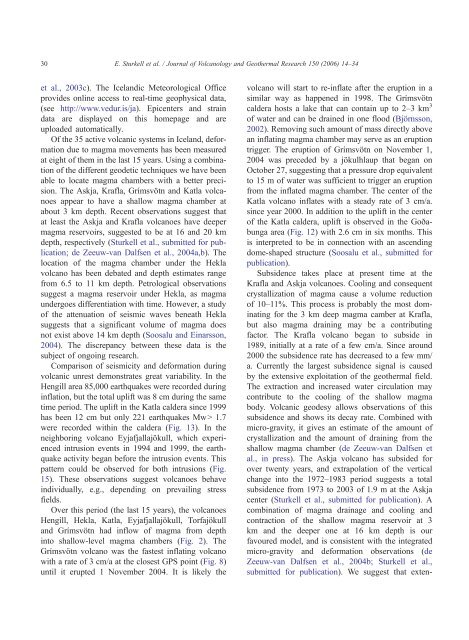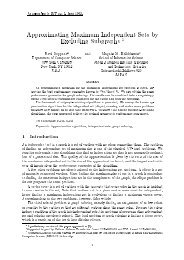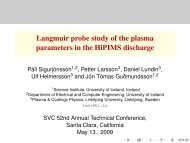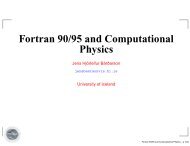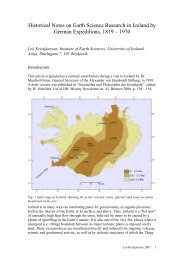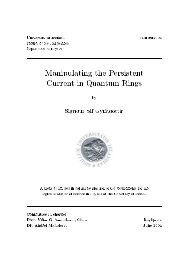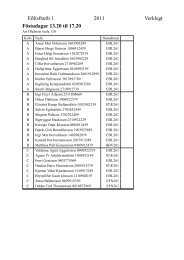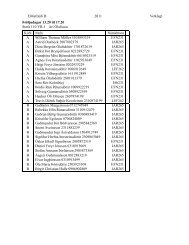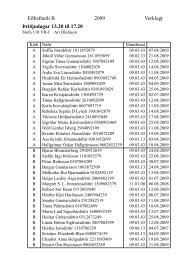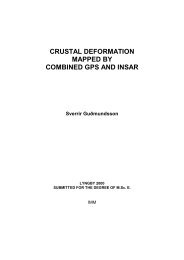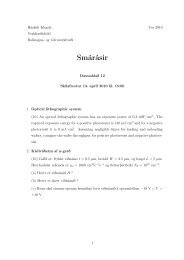Volcano geodesy and magma dynamics in Iceland - Acri-ST
Volcano geodesy and magma dynamics in Iceland - Acri-ST
Volcano geodesy and magma dynamics in Iceland - Acri-ST
You also want an ePaper? Increase the reach of your titles
YUMPU automatically turns print PDFs into web optimized ePapers that Google loves.
30E. Sturkell et al. / Journal of <strong>Volcano</strong>logy <strong>and</strong> Geothermal Research 150 (2006) 14–34et al., 2003c). The Icel<strong>and</strong>ic Meteorological Officeprovides onl<strong>in</strong>e access to real-time geophysical data,(see http://www.vedur.is/ja). Epicenters <strong>and</strong> stra<strong>in</strong>data are displayed on this homepage <strong>and</strong> areuploaded automatically.Of the 35 active volcanic systems <strong>in</strong> Icel<strong>and</strong>, deformationdue to <strong>magma</strong> movements has been measuredat eight of them <strong>in</strong> the last 15 years. Us<strong>in</strong>g a comb<strong>in</strong>ationof the different geodetic techniques we have beenable to locate <strong>magma</strong> chambers with a better precision.The Askja, Krafla, Grímsvötn <strong>and</strong> Katla volcanoesappear to have a shallow <strong>magma</strong> chamber atabout 3 km depth. Recent observations suggest thatat least the Askja <strong>and</strong> Krafla volcanoes have deeper<strong>magma</strong> reservoirs, suggested to be at 16 <strong>and</strong> 20 kmdepth, respectively (Sturkell et al., submitted for publication;de Zeeuw-van Dalfsen et al., 2004a,b). Thelocation of the <strong>magma</strong> chamber under the Heklavolcano has been debated <strong>and</strong> depth estimates rangefrom 6.5 to 11 km depth. Petrological observationssuggest a <strong>magma</strong> reservoir under Hekla, as <strong>magma</strong>undergoes differentiation with time. However, a studyof the attenuation of seismic waves beneath Heklasuggests that a significant volume of <strong>magma</strong> doesnot exist above 14 km depth (Soosalu <strong>and</strong> E<strong>in</strong>arsson,2004). The discrepancy between these data is thesubject of ongo<strong>in</strong>g research.Comparison of seismicity <strong>and</strong> deformation dur<strong>in</strong>gvolcanic unrest demonstrates great variability. In theHengill area 85,000 earthquakes were recorded dur<strong>in</strong>g<strong>in</strong>flation, but the total uplift was 8 cm dur<strong>in</strong>g the sametime period. The uplift <strong>in</strong> the Katla caldera s<strong>in</strong>ce 1999has been 12 cm but only 221 earthquakes MwN 1.7were recorded with<strong>in</strong> the caldera (Fig. 13). In theneighbor<strong>in</strong>g volcano Eyjafjallajökull, which experienced<strong>in</strong>trusion events <strong>in</strong> 1994 <strong>and</strong> 1999, the earthquakeactivity began before the <strong>in</strong>trusion events. Thispattern could be observed for both <strong>in</strong>trusions (Fig.15). These observations suggest volcanoes behave<strong>in</strong>dividually, e.g., depend<strong>in</strong>g on prevail<strong>in</strong>g stressfields.Over this period (the last 15 years), the volcanoesHengill, Hekla, Katla, Eyjafjallajökull, Torfajökull<strong>and</strong> Grímsvötn had <strong>in</strong>flow of <strong>magma</strong> from depth<strong>in</strong>to shallow-level <strong>magma</strong> chambers (Fig. 2). TheGrímsvötn volcano was the fastest <strong>in</strong>flat<strong>in</strong>g volcanowith a rate of 3 cm/a at the closest GPS po<strong>in</strong>t (Fig. 8)until it erupted 1 November 2004. It is likely thevolcano will start to re-<strong>in</strong>flate after the eruption <strong>in</strong> asimilar way as happened <strong>in</strong> 1998. The Grímsvötncaldera hosts a lake that can conta<strong>in</strong> up to 2–3 km 3of water <strong>and</strong> can be dra<strong>in</strong>ed <strong>in</strong> one flood (Björnsson,2002). Remov<strong>in</strong>g such amount of mass directly abovean <strong>in</strong>flat<strong>in</strong>g <strong>magma</strong> chamber may serve as an eruptiontrigger. The eruption of Grímsvötn on November 1,2004 was preceded by a jökulhlaup that began onOctober 27, suggest<strong>in</strong>g that a pressure drop equivalentto 15 m of water was sufficient to trigger an eruptionfrom the <strong>in</strong>flated <strong>magma</strong> chamber. The center of theKatla volcano <strong>in</strong>flates with a steady rate of 3 cm/a.s<strong>in</strong>ce year 2000. In addition to the uplift <strong>in</strong> the centerof the Katla caldera, uplift is observed <strong>in</strong> the Goðabungaarea (Fig. 12) with 2.6 cm <strong>in</strong> six months. Thisis <strong>in</strong>terpreted to be <strong>in</strong> connection with an ascend<strong>in</strong>gdome-shaped structure (Soosalu et al., submitted forpublication).Subsidence takes place at present time at theKrafla <strong>and</strong> Askja volcanoes. Cool<strong>in</strong>g <strong>and</strong> consequentcrystallization of <strong>magma</strong> cause a volume reductionof 10–11%. This process is probably the most dom<strong>in</strong>at<strong>in</strong>gfor the 3 km deep <strong>magma</strong> camber at Krafla,but also <strong>magma</strong> dra<strong>in</strong><strong>in</strong>g may be a contribut<strong>in</strong>gfactor. The Krafla volcano began to subside <strong>in</strong>1989, <strong>in</strong>itially at a rate of a few cm/a. S<strong>in</strong>ce around2000 the subsidence rate has decreased to a few mm/a. Currently the largest subsidence signal is causedby the extensive exploitation of the geothermal field.The extraction <strong>and</strong> <strong>in</strong>creased water circulation maycontribute to the cool<strong>in</strong>g of the shallow <strong>magma</strong>body. Volcanic <strong>geodesy</strong> allows observations of thissubsidence <strong>and</strong> shows its decay rate. Comb<strong>in</strong>ed withmicro-gravity, it gives an estimate of the amount ofcrystallization <strong>and</strong> the amount of dra<strong>in</strong><strong>in</strong>g from theshallow <strong>magma</strong> chamber (de Zeeuw-van Dalfsen etal., <strong>in</strong> press). The Askja volcano has subsided forover twenty years, <strong>and</strong> extrapolation of the verticalchange <strong>in</strong>to the 1972–1983 period suggests a totalsubsidence from 1973 to 2003 of 1.9 m at the Askjacenter (Sturkell et al., submitted for publication). Acomb<strong>in</strong>ation of <strong>magma</strong> dra<strong>in</strong>age <strong>and</strong> cool<strong>in</strong>g <strong>and</strong>contraction of the shallow <strong>magma</strong> reservoir at 3km <strong>and</strong> the deeper one at 16 km depth is ourfavoured model, <strong>and</strong> is consistent with the <strong>in</strong>tegratedmicro-gravity <strong>and</strong> deformation observations (deZeeuw-van Dalfsen et al., 2004b; Sturkell et al.,submitted for publication). We suggest that exten-


